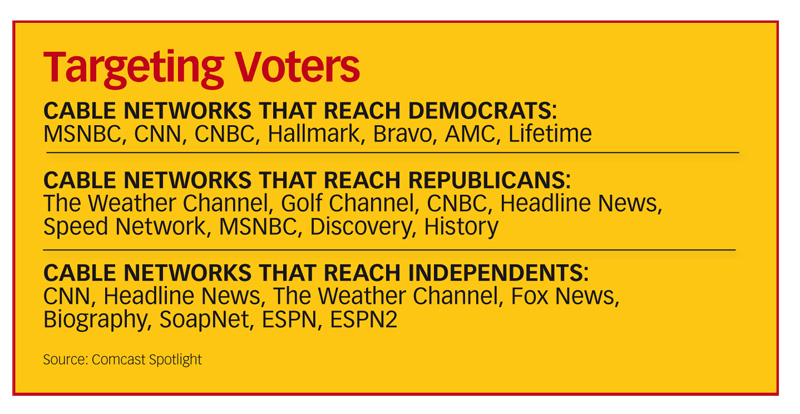Cable Campaigns For Candidate Cash

RELATED:Election News Draws Sponsors
The New Technology Of Campaign Coverage
Next Generation Coverage Arrives in Time for 2012
Getting Graphic Results
Local cable is stumping for dollars during this election cycle.
With an ability to target viewers by geography and reach voters with interactive advertising, Comcast Spotlight, the local cable sales arm of the largest cable operator, expects its share of campaign spending to rise. TV stations, on the other hand, say they expect to continue to get the vast majority of election-year political spending.
Cable’s share of local-TV campaign advertising has grown steadily since 2004, when cable captured only 3% of spending, according to Dan Sinagoga, VP of political advertising at Comcast Spotlight. That share rose to 15% in 2006 and 17% in 2008. In 2010, he says cable grabbed a 20% share.
With forecasts calling for 2012 campaign spending to hit as much as $4 billion, Sinagoga expects cable to capture between a 20% and 25% share. “We certainly don’t look at taking steps backwards off that 20%,” he says.
Sinagoga says cable has had to convince campaign managers that it had something worth buying. For one thing, more than half of TV viewing happens on cable these days, and voters don’t only watch the local news. (Voter groups can be targets by buying certain channels; see chart.) For another, with cable, you don’t have to buy an entire market, just the parts that are in the candidate’s district. In some cases, like one in Michigan, a single district has homes in the Detroit DMA, the Lansing DMA and the Grand Rapids DMA. Buying all three markets would be prohibitively expensive, he says.
“The name of the political game right now is microtarget, micro-target, micro-target,” Sinagoga says. “You can’t do that with anyone else but spot cable.”
Like Republicans and Democrats, broadcasters tend to look at the market differently than cable execs.
Jack Poor, VP of marketing insights at the Television Bureau of Advertising (TVB), figures that in the last election, stations pulled in $2.2 billion in campaign ads, with cable getting about $400 million. “I’ve got them at about 15% or 16%, and we don’t think that’s going to change much,” Poor says.
As for geotargeting, Poor says, cable’s zones don’t necessarily correspond to legislative districts. “You’ll often find that you’ve got to buy more than one zone, sometimes as many as four, to cover a congressional district,” he says.
Poor says cable gets a portion of its campaign money after broadcast stations sell out. “As these campaigns spend more and more money, and as the spending cycle stays compressed within a relatively short window, then the lesser preferred media is going to do better simply because there’s going to be no room at the inn further up the food chain,” he says. “That being said, they’re not doing significantly better than they had been in the past.”
Cable offers interactive opportunities for candidates. When Meg Whitman ran for governor in California last year, she used Comcast’s Request for Information (RFI) product and got 18,000 leads, of which 10,000 became active supporters. Comcast is also rolling out telescoping ads that allow a viewer to go from a short-form spot to a longer piece of content stored on the cable operators’ video-on-demand system. “We think that’s impactful,” Sinagoga says.
“That’s hype,” Poor counters. “Talk to any political campaign about that. If they’re using it, it’s the cherry on the sundae, but most of them aren’t even using it.
“They’re very, very focused on the basics and executing the basics well,” he adds. “And that’s buying air-time, trafficking it and making the changes they need along the way. The frenzy that these guys are in really doesn’t allow them to dabble much in video on demand and interactive and that kind of stuff.”
E-mail comments to jlafayette@nbmedia.com and follow him on Twitter: @jlafayette
Broadcasting & Cable Newsletter
The smarter way to stay on top of broadcasting and cable industry. Sign up below
Jon has been business editor of Broadcasting+Cable since 2010. He focuses on revenue-generating activities, including advertising and distribution, as well as executive intrigue and merger and acquisition activity. Just about any story is fair game, if a dollar sign can make its way into the article. Before B+C, Jon covered the industry for TVWeek, Cable World, Electronic Media, Advertising Age and The New York Post. A native New Yorker, Jon is hiding in plain sight in the suburbs of Chicago.

